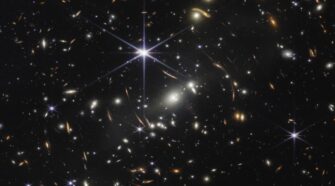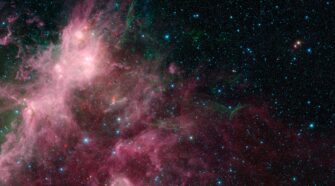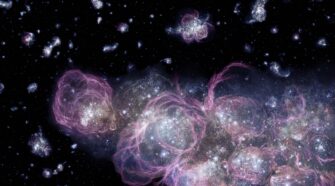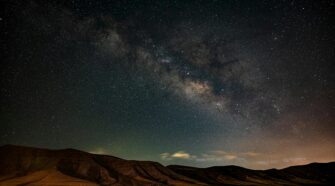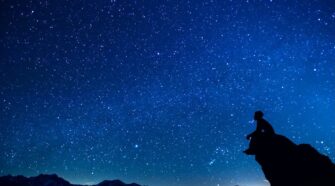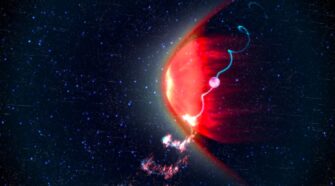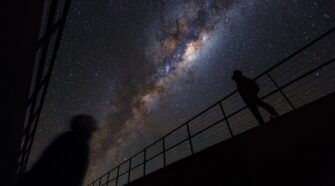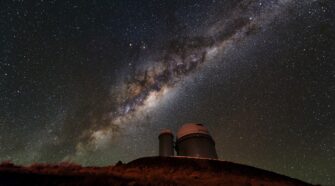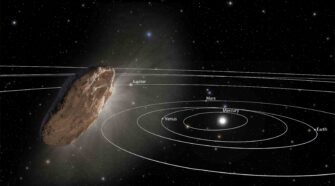Universe
Why isn’t there any sound in space?
“How far can sound travel through space, since it’s so empty? Is there an echo in space?” — Jasmine, age 14, Everson, Washington In space, no one can hear you scream. You may have heard this saying. It’s the tagline from the famous 1979 science fiction movie “Alien.” It’s a scary thought, but is it …
What is the universe expanding into if it’s already infinite?
“What is the universe expanding into if it’s already infinite?” — Mael, age 10, Missoula, Montana When you bake a loaf of bread or a batch of muffins, you put the dough into a pan. As the dough bakes in the oven, it expands into the baking pan. Any chocolate chips or blueberries in the …
How could an explosive Big Bang be the birth of our universe?
“How can a Big Bang have been the start of the universe, since intense explosions destroy everything?” — Tristan S., age 8, Newark, Delaware Pretend you’re a perfectly flat chess piece in a game of chess on a perfectly flat and humongous chessboard. One day you look around and ask: How did I get here? …
What is space made of? Explaining the components from radiation to dark matter
“What is space made of – what does gravity actually bend?” — Phil, age 12, Birmingham What comes to mind when you think of space? Imagine a friend boasting about a spacious building, stadium or museum they recently visited. Do you envision the building as vast and expansive? Is it simply very large, or does …
Does outer space end – or go on forever?
“What is beyond outer space?” — Siah, age 11, Fremont, California Right above you is the sky – or as scientists would call it, the atmosphere. It extends about 20 miles (32 kilometers) above the Earth. Floating around the atmosphere is a mixture of molecules – tiny bits of air so small you take in …
Twinkling star reveals the secrets of plasma structures in our cosmic neighbourhood
With the most powerful radio telescope in the southern hemisphere, we have observed a twinkling star and discovered an abundance of mysterious plasma structures in our cosmic neighbourhood. The plasma structures we see are variations in density or turbulence, akin to interstellar cyclones stirred up by energetic events in the galaxy. The study, earlier this …
When you wish upon a star, is it already dead?
Deep in the Chilean Desert, astronomers witness a skyscape like few others on Earth. Credit: ESO/Luis Calçada/Herbert Zodet When you wish upon a star, Jiminy Cricket told us, your dreams come true. But according to an idea doing the rounds on social media, that may not be the case: According to astronomy, when you wish …
How many stars are there in the Universe?
“Exactly how many stars are in space?” — MeeSong, Brookline Massachusetts Look up at the sky on a clear night, and you’ll see thousands of stars – about 6,000 or so. But that’s only a tiny fraction of all the stars out there. The rest are too far away for us to see them. The …
Here’s how we can study interstellar objects passing through solar system
In late 2017, a mysterious object tore through our solar system at breakneck speed. Astronomers scrambled to observe the fast moving body using the world’s most powerful telescopes. It was found to be one quarter mile (400m) long and very elongated – perhaps 10 times as long as it was wide. Researchers named it ‘Oumuamua, …
Do photons wear out? How light has ability to travel vast cosmic distances without losing energy
My telescope, set up for astrophotography in my light-polluted San Diego backyard, was pointed at a galaxy unfathomably far from Earth. My wife, Cristina, walked up just as the first space photo streamed to my tablet. It sparkled on the screen in front of us. “That’s the Pinwheel galaxy,” I said. The name is derived …

